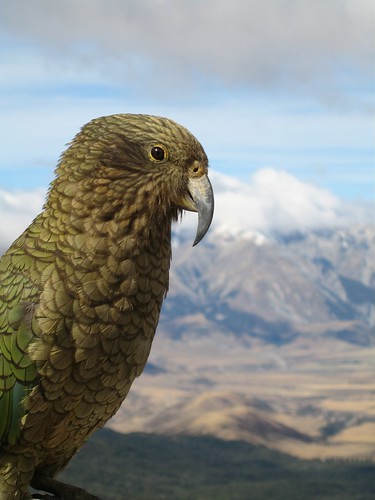Poisoned parrots may create shift in New Zealand possum-control policies
 Tuesday, July 29, 2008 at 15:00
Tuesday, July 29, 2008 at 15:00  One of a gang of juvenile kea romping about on the mountain side around the Broken River Skifield. Photo: Jon SullivanOne of the world's most intelligent birds is also one of its most endangered. New Zealand's kea parrot used to be a common sight in the island nation. But the kea is a voracious hunter, and has actually been known to prey upon sheep, which resulted in more than 100 years of government-sponsored bounties that nearly wiped out the species. Now, only 1,000 to 5,000 birds remain, mostly in remote mountain regions, where their food sources are being destroyed out by human development.
One of a gang of juvenile kea romping about on the mountain side around the Broken River Skifield. Photo: Jon SullivanOne of the world's most intelligent birds is also one of its most endangered. New Zealand's kea parrot used to be a common sight in the island nation. But the kea is a voracious hunter, and has actually been known to prey upon sheep, which resulted in more than 100 years of government-sponsored bounties that nearly wiped out the species. Now, only 1,000 to 5,000 birds remain, mostly in remote mountain regions, where their food sources are being destroyed out by human development.
While New Zealand's Department of Conservation has taken many steps to preserve the kea, the need to eliminate out another creature has taken a greater priority. Invasive possums plague the country, consuming tons of native plants and bird eggs every year, and carrying bovine tuberculosis, which they spread to livestock, deer and other species.
For years now, New Zealand has used a poison called 1080 (sodium monofluoroacetate) to try to control the possum problem. The poison is dropped from planes, with the hope that only the possums will eat it.
If only it were that simple.
A recent test aimed to find out if 1080 was killing endangered kea. Guest what -- it was. Nearly half of a small population of birds ate the poison and died.
A draft report on the deaths concludes that the DOC should review its policies on 1080 use, especially near kea populations.
This isn't the first time that the use of 1080 has been criticized. According to a report last year from The New Zealand Herald,
"...opponents say the poison kills not only pests, but also native birds and wildlife such as kiwi... Hunters oppose 1080 because it kills deer and recreationists say it makes a mockery of New Zealand's claim to be clean, pure and green."
Australian brush-tailed possums were introduced to New Zealand in 1837 for their fur. But the species has now spread over 99% of New Zealand, and estimates say there are now 20 possums in the country for every human. Ironically, they are actually protected in their native Australia.
 Nestor notabilis - Kea | in
Nestor notabilis - Kea | in  Conservation,
Conservation,  Disease,
Disease,  Introduced predators
Introduced predators 
